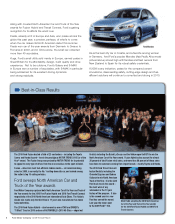Ford 2009 Annual Report Download - page 17
Download and view the complete annual report
Please find page 17 of the 2009 Ford annual report below. You can navigate through the pages in the report by either clicking on the pages listed below, or by using the keyword search tool below to find specific information within the annual report.
Management’s Discussion and Analysis of Financial Condition and Results of Operations
Ford Motor Company | 2009 Annual Report 15
While the economic outlook is improving, it is rebounding from a very low base and with a range of possible outcomes
due to the uncertain financial market environment and dependence upon ongoing policy responses. The consumer and
commercial sectors of the global economy appear to be improving, although recovery remains fragile due to continuing
tightness in the credit markets, weak labor markets in many countries, and uncertainty regarding the timing and magnitude
by which governments and central banks will remove stimulus programs. Although the housing market is stabilizing in the
worst hit markets, such as the United States, the United Kingdom, and Spain, challenges remain associated with rising
foreclosure rates and excess housing stocks.
In 2009, global industry vehicle sales volume is estimated to have declined to about 64.3 million units, down about
4 million units or 6% from 2008 levels. Global industry sales volume is projected to increase from the depressed 2009
levels, to a range of 65 million units to 75 million units for 2010.
Excess Capacity. According to CSM Worldwide, an automotive research firm, in 2009 the estimated automotive
industry global production capacity for light vehicles (about 86 million units) exceeded global production by about 29 million
units. In North America and Europe, the two regions where the majority of revenue and profits are earned in the industry,
excess capacity was an estimated 96% and 37%, respectively, with North America in particular driven up from recent rates
of around 43% due to the industry conditions in that market last year. According to production capacity data projected by
CSM Worldwide, global excess capacity conditions could continue for several years at an average of 21 million units per
year during the 2010-2014 period.
Pricing Pressure. Excess capacity, coupled with a proliferation of new products being introduced in key segments by the
industry, will keep pressure on manufacturers' ability to increase prices on their products. In addition, the incremental new
U.S. manufacturing capacity of Japanese and Korean manufacturers in recent years has contributed, and is likely to
continue to contribute, to pricing pressure in the U.S. market. The reduction of real prices for similarly contented vehicles in
the United States has become more pronounced since the late 1990s, and we expect that a challenging pricing environment
will continue for some time to come.
Consumer Spending and Credit. Limited ability to increase vehicle prices has been offset in recent years, at least in part,
by the long-term trend toward purchase of higher-end, more expensive vehicles and/or vehicles with more features. The
current retrenchment in consumer spending is likely to dampen that trend in the near-term. Over the long term, spending on
new vehicles is expected to resume its correlation with growth in per capita incomes. Emerging markets also will contribute
an increasing share of global industry sales volume and revenue, as growth in wholesales (i.e., volume) will be greatest in
emerging markets in the next decade. We believe, however, the mature automotive markets (e.g., North America, Western
Europe, and Japan) will retain the largest share of global revenue over the coming decade.
Commodity and Energy Price Increases. Commodity prices have resumed upward movement since early 2009. Despite
weak demand conditions, oil prices increased from around $40 per barrel in January to $80 per barrel in December of 2009.
With the global economic outlook improving and financial investment returning to commodity and oil markets, we expect
commodity and oil prices to continue trending upward with potentially higher volatility. Higher fuel prices, combined with
efforts to achieve environmental policy objectives, are likely to continue to generate demand for more fuel-efficient vehicles.
Currency Exchange Rate Volatility. The ongoing deleveraging in financial markets has generated significant volatility in
currencies as well. Recently, the U.S. dollar has gained some ground against the British pound and euro.
Other Economic Factors. The eventual implications of significant fiscal stimulus, including higher government deficits
generating potentially higher long-term interest rates, could drive a higher cost of capital over our planning period. Higher
interest rates and/or taxes to address the higher deficits may also impede real GDP growth and, therefore, vehicle sales
over our planning period.
























